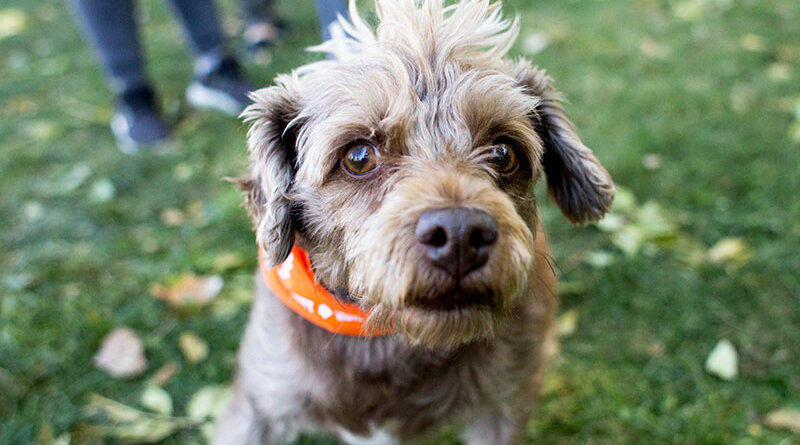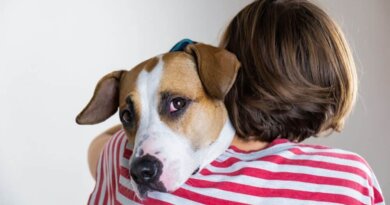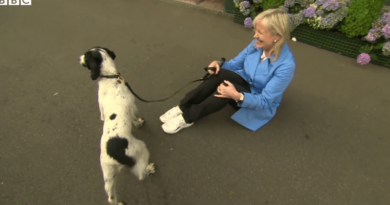Social Distancing On Dog Walks
It’s new, this widespread practice of people and their dogs socially distancing from others while on walks. Though not pleasing to everyone, I think a lot of good has come from this particular societal change. I have long believed that random on-leash greetings can be problematic.
Some dogs—even those who get along well with others when off-leash—don’t like to be greeted when they’re on-leash and unable to decline the opportunity. Other dogs are pushy, which ruins the experience for those they greet. Plenty of dogs are cautious and would rather just walk on by.
Perhaps the biggest issue is that many owners do not recognize the signs of distress, anxiety, nervousness or fear in their dogs during a greeting that isn’t going well. Instead of removing their dogs from a situation that’s upsetting them, they remain in place. As behavioral geneticist Alice Moon-Fanelli, PhD, CAAB, observed in an opinion shared by many canine professionals, “I think it’s fabulous that owners are being obligated to learn to teach their dogs to focus on the owners and social distance. …The casual free-for-all introductions trouble me big time.”
Will we or won’t we? Uncertainty about dog-dog greetings leads to tension
In the before times, when walkers and their dogs approached one another, there was often uncertainty about whether there would be a greeting. The “will we or won’t we?” greeting conundrum causes angst and excitement, which motivates dogs to act out in ways based on their personalities. Social dogs try to make contact by pulling, barking and whining, and fearful dogs do their best to avoid contact by pulling, barking and whining. Both types of dogs are letting their owners know what they want. So often, inconsistency about greeting other dogs while on-leash is part of the problem. Many dogs get themselves really worked up, perhaps because they don’t know what’s about to happen and are trying to express their preference. Suspense and inconsistency are not ideal for keeping a dog calm and in control. Now, there’s no uncertainty about the situation. The answer is always no.
GET THE BARK IN YOUR INBOX!
Sign up for our newsletter and stay in the know.
Young dogs are learning self-control
There is a huge benefit, especially for young dogs, who are learning to practice self- and impulse control, to not greeting other dogs while out on walks. Developing those skills is critically important for them to mature into pleasant, polite adults who are able to handle all kinds of situations, including those they may not thoroughly enjoy. Learning good manners is often about controlling oneself, and dogs who have to watch other dogs walk on by when they want to greet them are practicing that on a daily basis. Exuberant, friendly dogs of any age may not love social distancing, but they can benefit from it, nonetheless.
Social distancing offers many training opportunities for dogs
Teaching a dog to do something other than run up to greet another dog takes a considerable amount of effort, and lately, more people are focusing on it. As Barbara Long, professional dog trainer and owner of Paw in Hand Dog Training in Chapel, Hill, N.C., notes, “It has been an excellent training opportunity. My own puppy loves every dog she sees and thinks that all dogs love her. It’s so good for her to learn that she can look at other dogs without meeting them.” Many dog owners have noticed that their dogs also love the extra treats they get as they change direction on cue, crossing the street or heading off the side of the trail when they see other people and dogs coming. Happily, this extra training is making some dogs more attentive and responsive to cues in other contexts as well.
Shy dogs are in heaven!
For dogs who are shy or scared and prefer not to meet new dogs, social distancing is the best thing ever. Many owners are noticing that their shy dogs seem more secure. After months of not having to cope with dogs running up to them or people trying to pet them, they are less vigilant and more relaxed.
People with reactive dogs may love this new normal the most
For people whose dogs are reactive or aggressive, this may be the best thing that’s happened to them in a long time. With other owners keeping themselves and their dogs at a distance, life has gotten a lot easier for anyone dealing with a dog who’s at her worst when approached. Not only does it make each walk a better experience—not so stressful or requiring such constant vigilance—but many of these dogs are improving overall and becoming less reactive.
After months of having far fewer experiences that cause them to react, they’re better able to deal with various triggers without reacting in a negative way. (The way dog trainers tend to express this is by noting that it’s easier for the dogs to stay “under threshold.”) As dogs who used to struggle go on many consecutive walks without a problem, they are adding to the daily successes that are so essential for long-term improvement. Each time a dog reacts on a walk, that dog is more likely to react again—even to milder triggers—because she’s primed. It’s kind of like getting the giggles and then even slightly amusing things cause you to laugh uncontrollably, or seeing a scary movie and then the smallest sound makes you jump.
It is, however, hard on social dogs and social people
Even with all of the concerns about on-leash greetings, I feel for the many dogs who enjoy greeting one another and aren’t able to do so. Humans and canines who seek frequent social interaction enjoy the greetings, conversations, hellos and meeting over smells in the grass. Not only do such individuals cherish the chance to connect with others they know, walks also offer opportunities to make new friends. Dogs are great social facilitators, and it’s easy to meet new people when you’re out walking your dog. The dogs greet, you get to talking, and the next thing you know, you’ve planned a weekend hike or arranged to meet up for cocktails. That was then, this is now, and the now is lacking in spontaneous contacts that lead to friendships. For dogs and people who love the interactions that happen on walks, it’s just a big bummer.
Greeting practice is good for some dogs
Here, I’m referring to dogs who need to practice greeting to remember how to do it correctly. It’s not a common problem; many dogs who don’t have good greeting skills don’t get any worse without opportunities. And very social dogs may get excited and overly enthusiastic when they’re finally able to greet other dogs, but they don’t truly forget how to do it. But for dogs who were never well socialized and had to be taught proper greeting skills when they were older, lack of practice can be an issue. It’s analogous to learning a foreign language as an adult: it’s never as good as your native language, and you require more practice at it to keep from forgetting what you learned.
What does this mean for socialization?
While it’s absolutely true that puppies have fewer opportunities to meet and greet other dogs and people, it’s important to question the assumption that this is a bad thing. Sure, it could pose socialization challenges for young dogs. However, it may make it easier to guarantee that all the exposures dogs have to people and other dogs are positive, which is the actual goal of socialization. When puppies were vulnerable to others charging up to them, there was always the chance that they would be scared, stressed or overwhelmed. With others at a distance, it’s far more likely that owners can control the situation for the sake of their new puppy by insisting others stay away without being perceived as rude or unfriendly. They can easily turn and walk away if they decide that’s what would best serve the puppy at that moment. They can offer treats, toys and happy talk every time a person or dog is in the vicinity without concern that the people or dogs will charge over and ruin a potentially positive experience.
Clearly, there are pluses and minuses to socially distancing on walks. On the up side, many dogs are happier and more confident, which allows them to learn and practice new skills. On the down side, the social opportunities for both people and dogs to greet one another while out on walks is greatly missed by many. Not all dogs are reacting the same way to the change. A friend has two dogs whose responses are exactly opposite one another. She describes her dogs’ experiences succinctly: “This is heaven for Saylor. She’d like everybody to remain physically distant for eternity! Marley, though. He’s not digging it at all.”
Has social distancing on walks affected your dog? We’d love to hear your take on the matter.





paxlovid buy https://paxlovid.bid/ paxlovid pharmacy